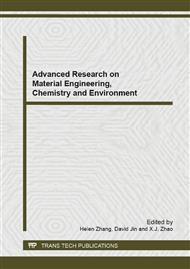p.428
p.434
p.440
p.444
p.450
p.456
p.460
p.466
p.471
Optimization of Ultrasonic-Assisted Regeneration Process for Coconut Shell Activated Carbon Based on Response Surface Method
Abstract:
The single-factorial design of experiments and response surface methodology was applied to optimize ultrasonic-assisted regeneration of coconut shell activated carbon. With the pH values of the solution, solid-liquid ratio, irradiation time chosen as the independent variable and the activated carbon release of antimony as response values, the central composite design method was used to study each of the variables and their interactions on coconut shell activated carbon regeneration. The results of this study showed that: the optimum pH value was 13; solid-liquid ratio was 372 mL·g-1; irradiation time was 6.7 h. The average content of the release of Sb from the activated carbon was 6233.95 μg·g-1 under the optimum condition. Regeneration rate of the activated carbon was 84.45%. This demonstrated that the adsorption efficiency of Sb was close in regenerative carbon and the original carbon. The results proved that the ultrasonic-associated coconut shell activated carbon regeneration process was accurate and reliable, and can provide a reference for the regeneration of coconut shell activated carbon which had adsorbed Sb.
Info:
Periodical:
Pages:
450-455
Citation:
Online since:
September 2013
Authors:
Price:
Сopyright:
© 2013 Trans Tech Publications Ltd. All Rights Reserved
Share:
Citation:


